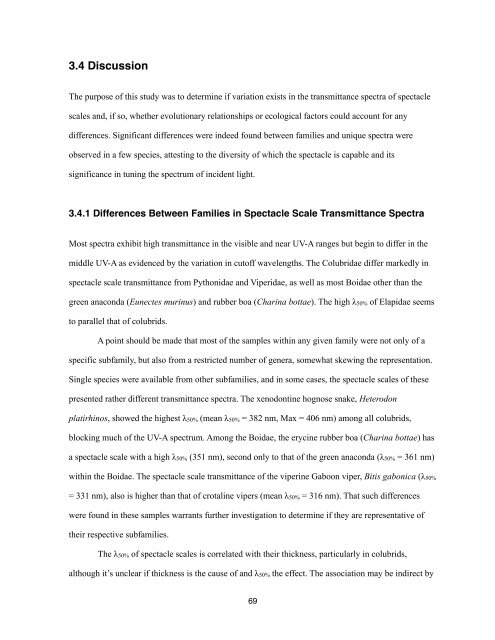Chapter 1, The Reptilian Spectacle - UWSpace - University of ...
Chapter 1, The Reptilian Spectacle - UWSpace - University of ...
Chapter 1, The Reptilian Spectacle - UWSpace - University of ...
You also want an ePaper? Increase the reach of your titles
YUMPU automatically turns print PDFs into web optimized ePapers that Google loves.
3.4 Discussion<br />
<strong>The</strong> purpose <strong>of</strong> this study was to determine if variation exists in the transmittance spectra <strong>of</strong> spectacle<br />
scales and, if so, whether evolutionary relationships or ecological factors could account for any<br />
differences. Significant differences were indeed found between families and unique spectra were<br />
observed in a few species, attesting to the diversity <strong>of</strong> which the spectacle is capable and its<br />
significance in tuning the spectrum <strong>of</strong> incident light.<br />
3.4.1 Differences Between Families in <strong>Spectacle</strong> Scale Transmittance Spectra<br />
Most spectra exhibit high transmittance in the visible and near UV-A ranges but begin to differ in the<br />
middle UV-A as evidenced by the variation in cut<strong>of</strong>f wavelengths. <strong>The</strong> Colubridae differ markedly in<br />
spectacle scale transmittance from Pythonidae and Viperidae, as well as most Boidae other than the<br />
green anaconda (Eunectes murinus) and rubber boa (Charina bottae). <strong>The</strong> high λ50% <strong>of</strong> Elapidae seems<br />
to parallel that <strong>of</strong> colubrids.<br />
A point should be made that most <strong>of</strong> the samples within any given family were not only <strong>of</strong> a<br />
specific subfamily, but also from a restricted number <strong>of</strong> genera, somewhat skewing the representation.<br />
Single species were available from other subfamilies, and in some cases, the spectacle scales <strong>of</strong> these<br />
presented rather different transmittance spectra. <strong>The</strong> xenodontine hognose snake, Heterodon<br />
platirhinos, showed the highest λ50% (mean λ50% = 382 nm, Max = 406 nm) among all colubrids,<br />
blocking much <strong>of</strong> the UV-A spectrum. Among the Boidae, the erycine rubber boa (Charina bottae) has<br />
a spectacle scale with a high λ50% (351 nm), second only to that <strong>of</strong> the green anaconda (λ50% = 361 nm)<br />
within the Boidae. <strong>The</strong> spectacle scale transmittance <strong>of</strong> the viperine Gaboon viper, Bitis gabonica (λ50%<br />
= 331 nm), also is higher than that <strong>of</strong> crotaline vipers (mean λ50% = 316 nm). That such differences<br />
were found in these samples warrants further investigation to determine if they are representative <strong>of</strong><br />
their respective subfamilies.<br />
<strong>The</strong> λ50% <strong>of</strong> spectacle scales is correlated with their thickness, particularly in colubrids,<br />
although it’s unclear if thickness is the cause <strong>of</strong> and λ50% the effect. <strong>The</strong> association may be indirect by<br />
69
















